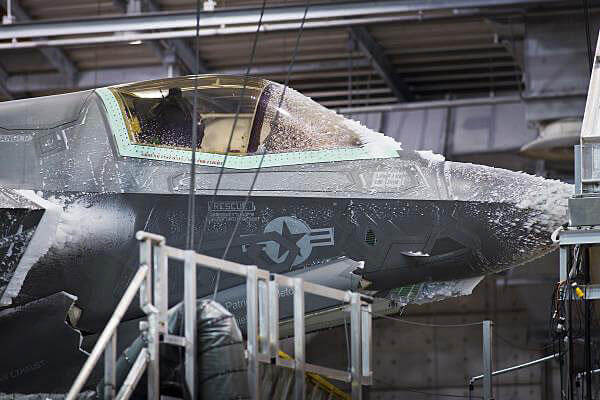F-35 test pilots are starting the aircraft's engine and simulating takeoffs in extreme cold temperatures with special arctic gear as a way to prepare the stealth fighter to perform in combat.
The testing, which will finish up at Eglin Air Force Base, Fla., in March, assesses the ability of the aircraft to start up, launch afterburners and even function in short-takeoff-and-landing, or STOVL, mode -- in extreme arctic temperatures, F-35 test pilot Cmdr. Tony "Brick" Wilson said.
"I was there for negative 15 degree Fahrenheit testing. It is really, really cold. It was kind of a surreal experience. When I walked into the cockpit, the plane had been sitting in negative 20 degrees for more than 24 hours. We would dress in arctic gear as we went out to the aircraft to start the evolution," he said. "The testing begins by ensuring that the entire place is either hot soaked or cold soaked."
In total, the Pentagon's F-35 Lightning II has been test-flying in extreme heat, artic cold, rain, humidity, ice and desert winds in a specially engineered climactic laboratory hangar at Eglin.
"They have been testing since September of last year. They are seeing how the components handle a range of weather conditions. In the hangar, they can replicate harsh desert winds and sun along with freezing rain conditions," said Joe DellaVedova, F-35 program spokesman.
The testing is designed to ensure that the avionics did not have any issues functioning at extreme temperatures, Wilson explained.
"We did numerous maintenance evolutions and engine starts as well as simulated takeoffs," he added. "Many legacy aircraft and fourth generation such as F-18, F-15 and F-16 aircraft have undergone similar testing and proven to withstand these temperatures."
With 13 countries currently involved with the program, the F-35 must be tested in meteorological conditions representative of those locations from which it will operate, ranging from the heat of Australia to the bitter cold of the Arctic Circle above Canada and Norway, an F-35 program office statement said.
The Air Force's 96th Test Wing's McKinley Climatic Laboratory, located at Eglin Air Force Base, is the world's largest climactic testing chamber. It is designed to replicate the full range of potential weather conditions in which the F-35 might need to fly, DellaVedova said.
"We've designed an environment here at the chamber where we can simulate virtually any weather condition -- all while flying the jet at full power in either conventional or vertical takeoff mode," Dwayne Bell, McKinley Climatic Laboratory technical chief, said in a written statement.
The ongoing tests are part of a six-month assessment of the F-35's ability to perform in wind, solar radiation, fog, humidity, rain, ice build-up, vortex icing and snow, officials said.
The testing includes flying the aircraft in extreme temperatures ranging from 120-degrees Fahrenheit to minus-40 degrees Fahrenheit.
During the testing, the aircraft is basically flying in place, meaning it is tethered down but fully powered up, allowing testers to simulate meteorological conditions with an operational aircraft, DellaVedova explained.
"To this point, the aircraft's performance is meeting expectations," said F-35 test pilot Billie Flynn. "It has flown in more than 100-degree heat while also flying in bitter subzero temperatures. In its final days of testing, it will fly through ice and other conditions such as driving rain with hurricane force winds."
Test pilots prepare for the extreme hot and cold weather testing by wearing special gear, Wilson said.
"We dress as though we are going to eject and we need to be able to survive in extreme temperatures," Wilson said.
For hot weather, the gear includes a special "cooling vest" designed for use with chem-bio technology to keep pilots cool when wearing protective equipment, he added.
For cold weather, pilots will use multiple layers, Wilson explained.
"We'll put a thermal layer of underwear and an additional thermal layer over that -- followed by a light suit and snow suit, which consists of a jumper and then a thick jacket that goes on. Then we have winter weight socks and arctic boots and winter weight flying gloves," he added.
The F-35 program is beginning to analyze the results of the ongoing test with a mind to making any adjustments that might be needed for the aircraft to maximize performance in various environments and climates across the globe.
"The jet tested really well during hot temperature testing. In cold weather, the oil did not flow as well. They are learning and testing," DellaVedova said.
Every aircraft in the Defense Department inventory has gone through climactic testing at the climactic laboratory at Eglin, which was completed in 1947 just after the end of WWII.
Since December 2006, the F-35 Lightning II has surpassed 25,000 combined flight hours with 16,200 hours in the F-35 military fleet aircraft and 8,950 hours of system development and demonstration testing, F-35 officials said.
The F-35 has completed multiple weapons tests as well as F-35B and F-35C first-life durability testing. Additionally, the test fleet has conducted two F-35B sea trials aboard a large amphibious assault ship -- the USS WASP (LHD 1), and last November the F-35C completed its first sea trial aboard an aircraft carrier -- the USS Nimitz.
-- Kris Osborn can be reached at Kris.Osborn@military.com.





























